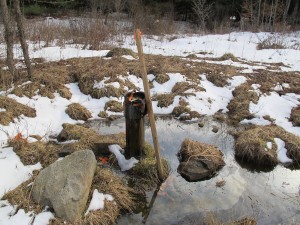NPR: Across PA, Abandoned Wells Litter The Land
-
Scott Detrow

Susan Phillips / StateImpact Pennsylvania
An abandoned well from the early 1900’s spews oil into the Tamarack Swamp.
This morning, NPR aired a StateImpact report on Pennsylvania’s estimated 200,000 abandoned oil and gas wells, and the problems caused this summer when a Tioga County Shell drilling operation intersected with an 80-year-old well. You can listen to the report here, and read our full series on the problem, Perilous Pathways, here.
From the Morning Edition report:
The gas didn’t come from the Butters well, nor did it originate from the Marcellus Shale formation that three nearby Shell wells had recently tapped into. What most likely happened to cause the geyser in June, Shell and state regulators say, was something of a chain reaction. As Shell was drilling and then hydraulically fracturing its nearby well, the activity displaced shallow pockets of natural gas. The gas disturbed by Shell’s drilling moved underground until it found its way to the Butters well, and then shot up to the surface.
Companies have been extracting oil and gas from Pennsylvania’s subsurface since 1859, when Edwin Drake drilled the world’s first commercial oil well. Over that 150-year period, as many as 300,000 wells have been drilled, an unknown number of them left behind as hidden holes in the ground. Nobody knows how many because most of those wells were drilled long before Pennsylvania required permits, record-keeping or any kind of regulation.
It’s rare for a modern drilling operation to intersect with an abandoned well. But incidents like Shell’s Tioga County geyser are a reminder of the dangers these many unplotted holes in the ground can cause when Marcellus or Utica Shale wells are drilled nearby.
















